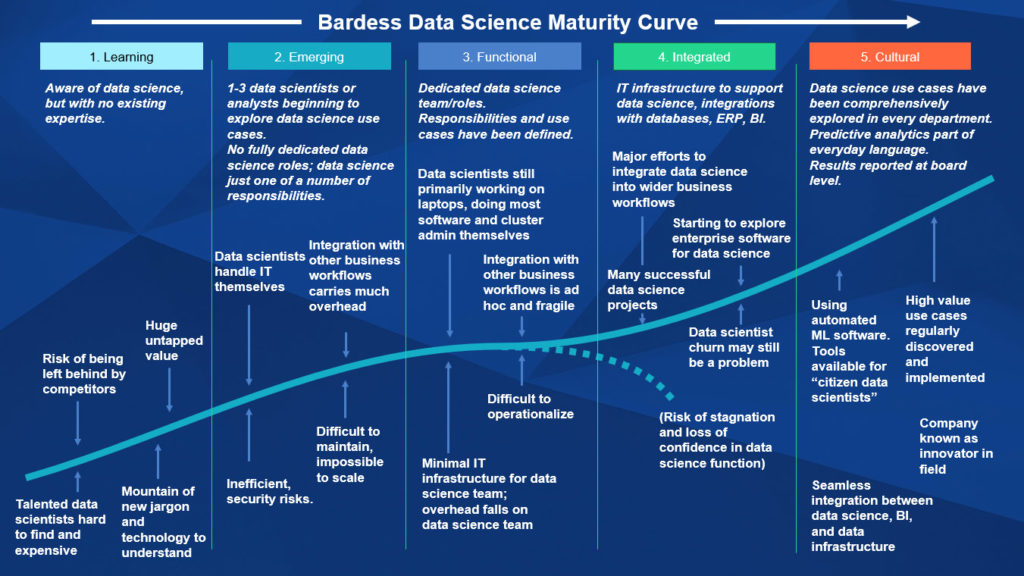It feels like data science is everywhere nowadays. Industry is awash with stories of how machine learning and artificial intelligence allow companies to extract maximum value from their data.
Use cases such as lead acquisition models, credit risk models and customer churn predictions can drive revenue and customer retention, while maximizing cost efficiency. On the other hand, companies that aim to become data science leaders face several unique challenges.
Given that data science is now firmly established in industry – seven years have passed since Harvard Business Review famously referred to data science as “The Sexiest Job of the 21st Century” – it is a great time to take stock and look at how data science is being implemented across industry. At Bardess, we have created the Data Science Maturity Curve to help our customers better understand their position in the data science space, and to better focus their energies to ensure successful growth.
Let’s start at the top of the maturity curve – data science nirvana.
These companies have been built up around data science from their inception, and it is part of their everyday language. It is Cultural for these companies, and you can probably guess some of the big-name companies we would put in this category. Every internal and external data source available has been scrutinized and considered for machine learning, and many high-value use cases have been extracted. The company looks to data scientists for innovation, and understands their technical and organizational needs.
Now let’s jump back to the beginning of the maturity curve. Companies that are just Learning about data science might be motivated by hearing about data science in the news, or by noticing their competition increasingly making use of machine learning techniques. However, a number of immediate challenges will confront them.
Firstly there is the mountain of complex language and jargon, making it difficult to understand which types of machine learning or AI use cases are most relevant. Hiring talented data scientists is also a challenge, especially without an existing data science practice.
Companies with Emerging data science functions have started to invest a little effort, but without dedicated data scientist roles, it can be difficult to make much headway in such an intensive subject. However, a new generation of software tools can pick up the slack for the companies such as these, e.g. the automated ML tool, DataRobot.
The Functional stage of data science maturity represents companies with dedicated teams and defined use cases, for whom nonetheless, data science may still be seen as something of a novelty. Without proper integration with technical and business workflows, actionable results may be limited, and there is a strong risk of stagnation.
A properly Integrated data science practice requires smooth and efficient integration with data architecture, BI tools, and internal and customer-facing apps. Again, software can help, such as Cloudera Data Science Workbench – a secure, self-service enterprise data science platform, which enhances the “ops” side of data science while reducing IT overhead. Good management is also vital to ensure that data scientists’ work translates into valuable and actionable business insights.
Continuing challenges include convincing the organization as a whole that data science can be used for effective decision-making, and ensuring that ML and AI use cases are considered in all areas, such as HR and operations – not just core revenue streams. Companies that have made the leap to the Cultural maturity stage have no fear about subjecting their datasets to the power of machine learning and artificial intelligence.
Bardess’s extensive experience in helping clients grow out their data science practice allows us to provide exceptional advice for a company looking to make the leap to the next stage of data science maturity. Want to learn more, or discuss what stage of the Data Science Maturity Curve your company is at? We would love to hear your thoughts, and you can contact us here.

